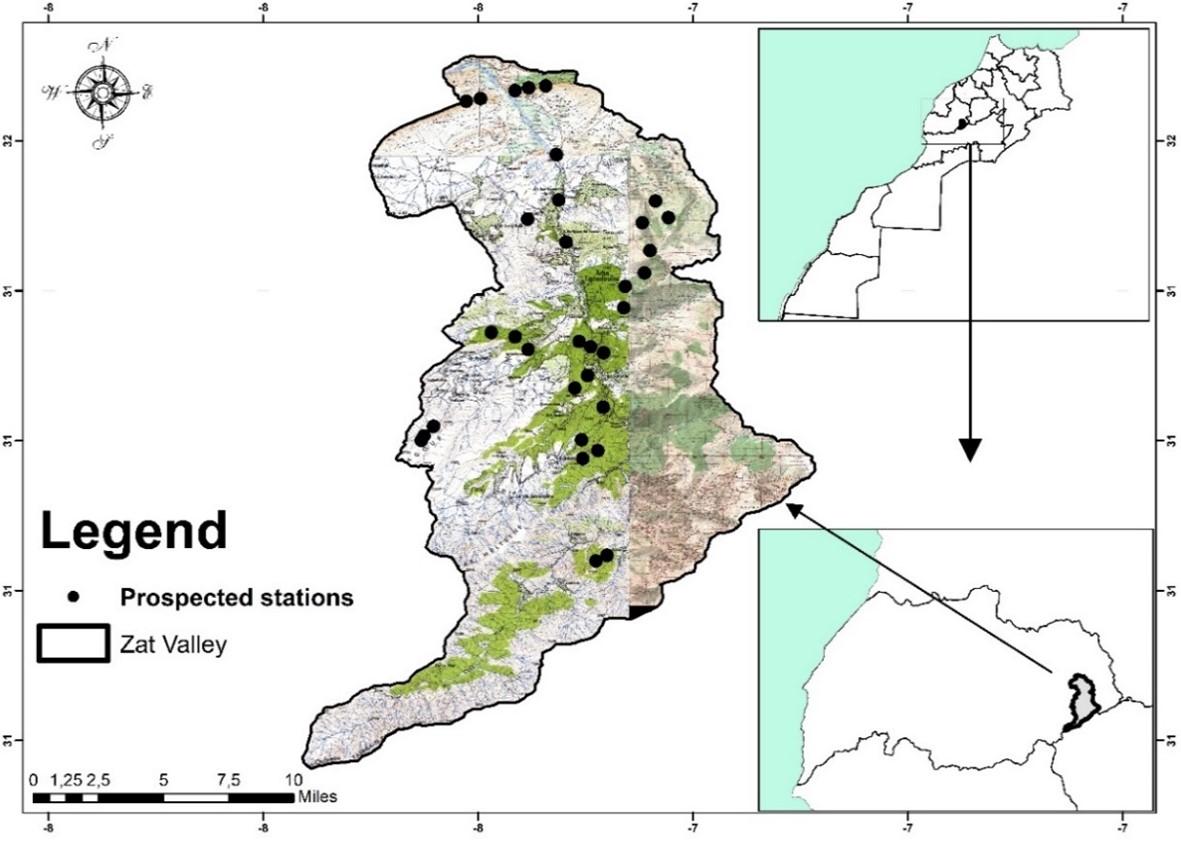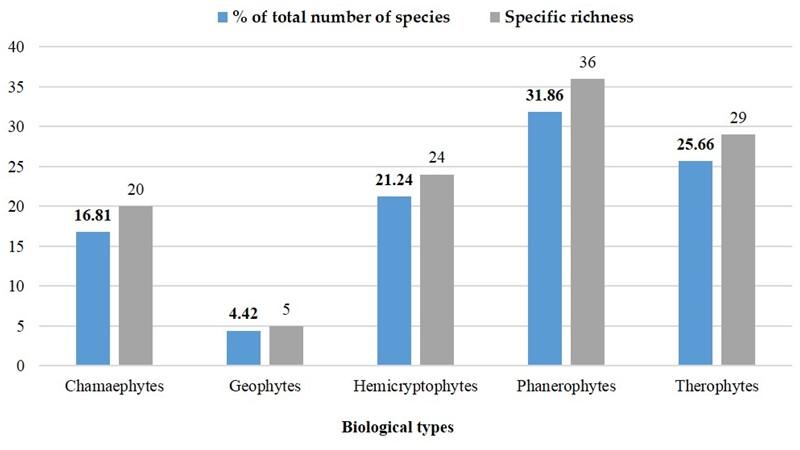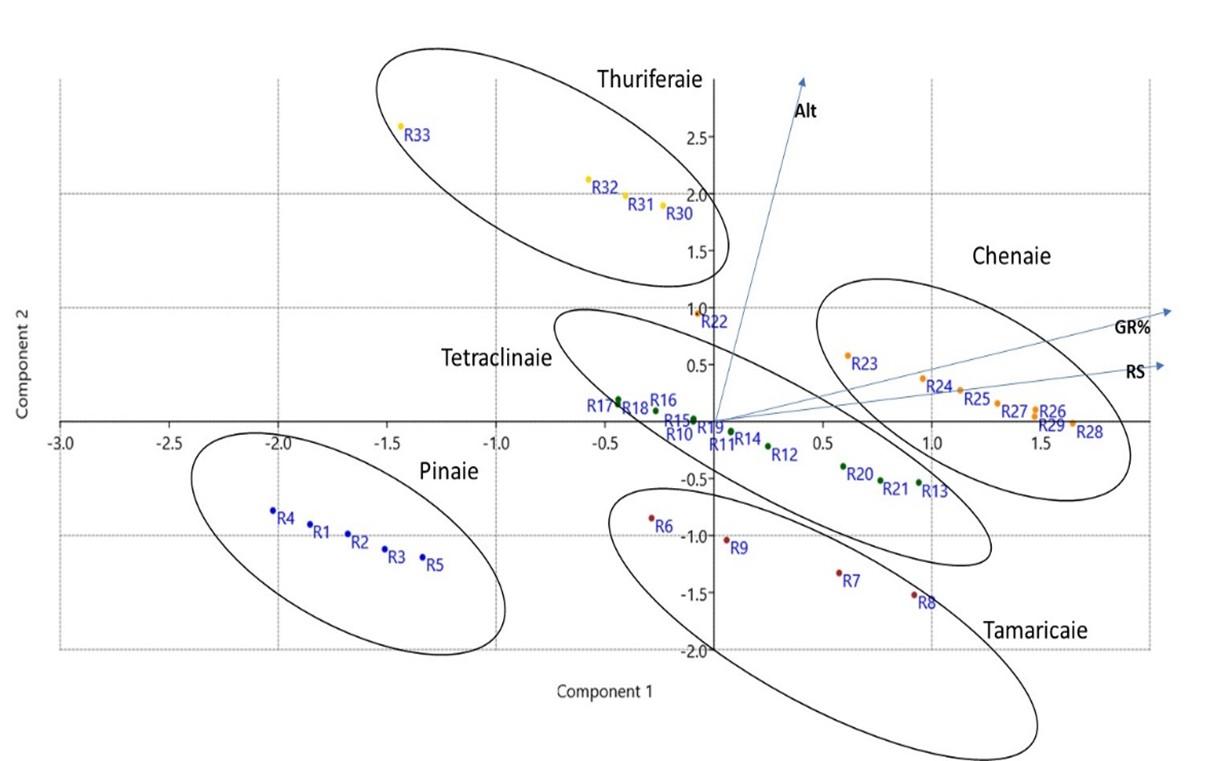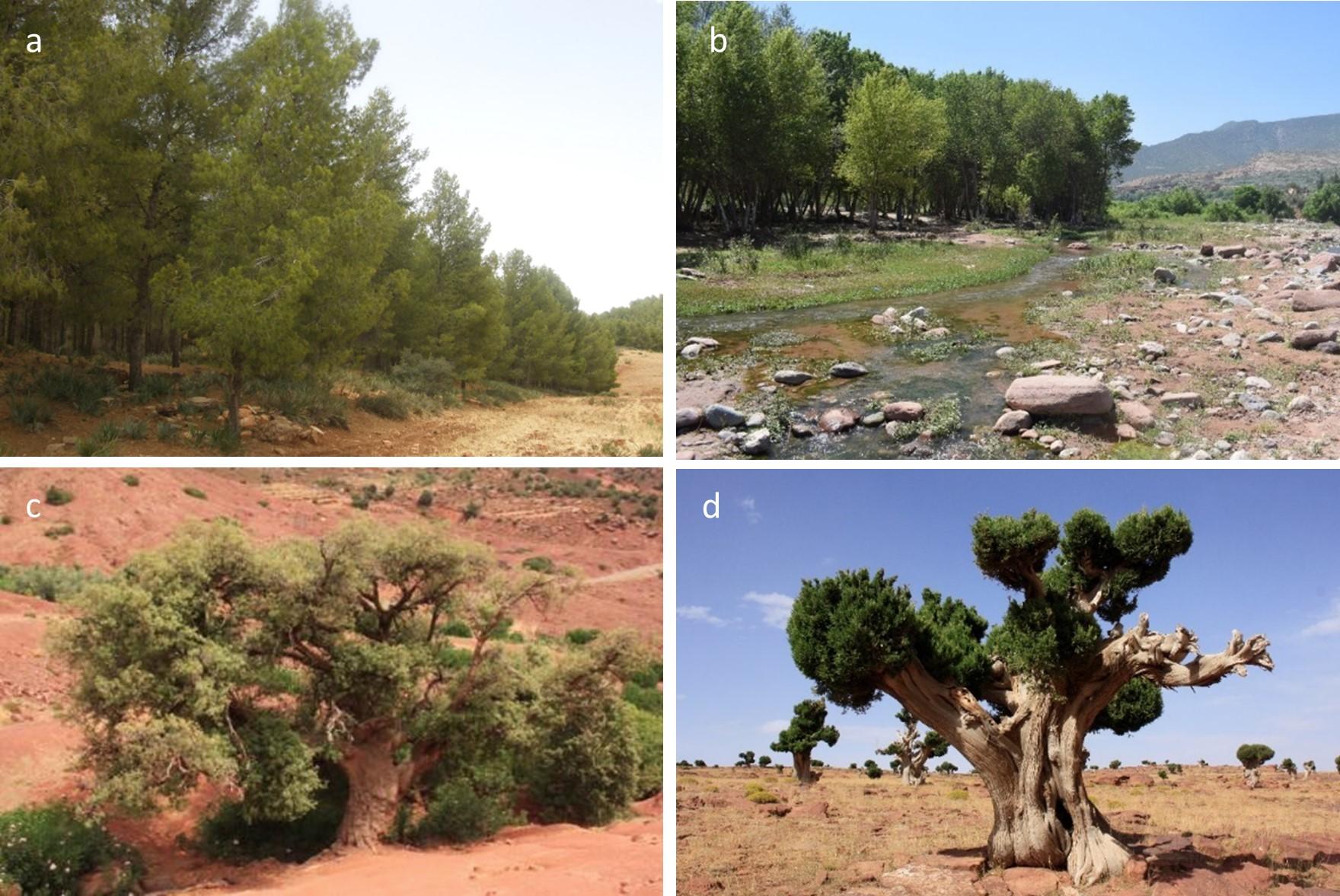Analysis of floristic diversity of the forest ecosystems of the Zat valley- High Atlas of Morocco: Valorization and Conservation perspectives
Abstract
From a management and conservation perspective, measuring the biodiversity of an ecosystem is an indispensable tool for assessing its health. Currently, scientists and authorities are giving great importance to the Zat valley because of its ecological, socio-economic and cultural importance. This study was carried out to assess the floristic biodiversity and to determine the different dominant plant groups in the Zat Valley. Based on 33 phyto-ecological surveys, the floristic diversity of the Zat valley revealed the existence of 114 species and subspecies distributed among 44 families and 96 genera, belonging to various biological types. As a first result, 9 taxa were reported as rare taxa according to the flora of Morocco, whereas 7 species were reported as rare and threatened species. A Correspondence Factor Analysis was performed in this study and allowed the individualization of five groups of plants: Pine formation, Thuja formation, Tamarix formation, Holm Oaks formation and Thuriferous formation, each of these formations was described by its geographical distribution, the biodiversity of its flora and its ecological conditions. This study provides an essential tool for the sustainable management of this valley through the implementation of a management and conservation plan.
INTRODUCTION
Morocco is one of the rarest countries in North Africa to have a set of endemic ecosystems with remarkable biodiversity particularly in terms of forest areas [1-2-3]. It is composed of four major high mountains: Rif, Middle Atlas, High Atlas and Anti Atlas, which are important sectors regarding endemism of vascular plants [3]. The Zat valley is located within the High Atlas Mountains, it is mainly composed of wet grasslands and pozzines, which constitute a highly coveted pastoral resource due to the geomorphology and evolution of surrounding slopes. Its flora is characterized by a great specific richness [4], for instance, in the case of high Atlas meadows, 4200 species were recorded distributed in 940 genus and 135 families where 550 species are endemic to Morocco [5].
The Zat Valley is considered one of the most watered valleys in the High Atlas due to the contribution of solid precipitation allowing a rich vegetation cover. There are few studies about vegetation in Zat Valley where tree main forests have been quoted: holm oak, Juniper and Thuja which are highly exploited by local population due to their socio-economical assets [7]. Moreover, only a few scientific works have been carried out to describe the main floristic diversity of this ecosystem [8].
Since it provides several ecosystem services, the vegetation of Zat Valley is threatened by the expansion and development of anthropogenic factors such as agriculture, industry and urbanization, which climate change is expected to further exacerbate, thus jeopardizing their integrity and sustainability.
The aim of the present work is to construct a floristic checklist and to develop a typology of plant communities and an interpretation of the relationships existing between these later and environmental factors using floristic and ecological descriptors.
MATERIALS AND METHODS
Study area
The Zat valley is located between 31° 17′ and 31° 32′ North and 07° 29′ and 07° 34′ West, it is integrated into the Tensift watershed and overlaps with two rural communes, Ait Ourir and Arbia Tighdouine (Figure 1). It is bounded to the south by the axial zone of the High Atlas, to the north by the Haouz plain, to the east by R’Dat basin and to the west by Ourika basin.
From a pedological point of view, the Zat valley is composed of 46 % impermeable land, 40 % semi-permeable land and 14 % permeable land [9]. Consequently, these geological formations favor a sustained surface flow and possibly the development of important floods in case of heavy rains [9].
The hydrographic network of the studied area is characterized by the Zat River which has its source at the foot of Taska n’Zat (3905 m) on the right bank and Tougroudaden (3736 m) on the left bank. It drains a catchment area of about 525 Km2 and flows from south to north to Aït Ourir where it branches into two parts, one joins the Oued Ourika, and the other the Oued Tensift.

Sampling
33 localities were surveyed in order to cover the entire study area. Floristic sampling was carried out according to the phytoecological approach described by Mueller-Dumbois and Ellenberg (1974) [10]. The principle of its establishment consisted in collecting data on physical environment and vegetation in the smallest area that contains almost all of a floristic homogenous surface (relevé) in order to have representative results of the entire study area. This method made it possible to define, analyze the different floristic groups and to highlight their relationships with the physical environment using fixed ecological and structural parameters. The main measured environmental parameters were altitude, slope and orientation, substrate and soil type, anthropogenic activities such as grazing intensity, fire and wood cutting.
As for the biological types, we adopted the life-forms of encountered species, according to the Raunkiær classification system [11], as follows: phanerophytes, chamaephytes, hemicryptophytes, therophytes and geophytes.
The collected specimens were dried and pressed using the herbarium press of Museum of Natural History in Marrakesh. They were then identified using the Practical flora of Morocco: manual of the determination of vascular plants [12-13] and by consulting old collection of herbarium of Museum of Natural History of Marrakesh. The status of the studied taxa was based on the catalogue of rare, threatened or endemic vascular plants in Morocco [14].
The Correspondence Factor Analysis (CFA) was performed in this study using Past software (version 3.1) [15] based on a table of 33 surveys (R.1 to 33) and described by 26 dominant species. Indeed, for this analysis, we selected only those species with an abundance-dominance index greater than or equal to 2.
RESULTS
Floristic composition
As a result of the examination of 33 phyto-ecological surveys, the Zat valley is characterized by a great floristic richness estimated to 114 vascular species (Table 1). These species are distributed among 96 genera and 44 botanical families. The most dominant family was Asteraceae with 11 species (9.73%), followed by Poaceae with 10 species (8.75%), Leguminoseae and Labietae with 7 species (6.19%) each, and Umbellifereae with 5 species (4.42%). The following 17 families are represented by a single species: Anacardiaceae, Apocynaceae, Convolvulaceae, Ericaceae, Fagaceae, Globulariaceae, Juglandaceae, Malvaceae, Moraceae, Myrtaceae, Papaveraceae, Punicaceae, Rosaceae, Rubiaceae, Tamaricaceae, Urticaceae, Zygophyllaceae (Table 1).
According to the catalogue of rare, threatened or endemic vascular plants of Morocco [18], the endemic flora in Zat valley is represented by nine species; seven of them are endemic to Morocco while two species are reported as sub-endemic (Table 2) whereas 7 taxa are reported as rare and threatened species, namely: Juniperus communis L; Juniperus thurifera subsp. africana. Maire; Matricaria aurea (Loefl.) Sch. Bip; Trifolium cernuum Brot; Diplotaxis ollivieri Maire; Poa pratensis L; and Rumex ginii Jahandiez and Maire.
According to Raunkiaer’s classification [11], this floristic list is dominated by Phanerophytes with 36 species (31.86%), followed by Therophytes with 29 species (25.66%), then Hemicryptophytes with 24 species (21.24%), Chamaephytes with 20 species (16.81%) and Geophytes with five species (4.42%) (Figure 2).
The sampled area has 6 halophilic species belonging to 4 different families according to the halophile flora [21]. We quote: Juncus acutus L., Salsola vermiculata L., Atreplix halimus L., Frankenia sp, Plantago coronopus L and Phragmite australis L. These species are located mostly in the Amassine River in the northwestern part of the study area.
Table 1. Specific richness and proportion relative of 37 families of Zat valley.
Table 2. List of endemic species of the Zat Valley “E: Moroccan endemic, A: endemic to Morocco and Algeria, I: Moroccan-Iberian.

Typology of plant groups
The processing of the CFA results showed the differentiation of five groups of plants (Figure 3), Pine formation, Tamarix formation, Thuja formation, Holm oaks formation and Thuriferous formation. Each type of these formations is defined by its geographical distribution, floristic biodiversity and ecological conditions.
Aleppo pine formation is located in the low altitudes between 600 and 800 m, often developed on a sandy clay soil poor in organic matter, with a low specific richness estimated by 9 taxa. This formation occupies a privileged space of the downstream part of the Zat valley (Figure 4), it shows the abundance of the following characteristic species: Pinus halepensis L, Juniperus phoenicea L, Chamaerops humilis L., Drimia maritima L., Asparagus albus L., Lygeum spartum L., Stipa capensis Thumb.
Tamarix formation is located in the alluvial zones of Zat River and its tributaries; it is along the river in Zat valley (Figure 4). It is generally narrow and forms a fringe about 100 m wide in which epiphytes, creepers and riparian plants are found. Tamarix formation includes: Tamarix africana L, Populus alba L., Salix pedicellata Desf., Nerium oleander L., Dittrichia viscosa L., Phragmite australis L., Arundo donax L., Juncus acutus L., we also noticed the presence of four rare and threatened species: Matricaria aurea (Loefl.) Sch. Bip. Trifolium cernuum Brot; Diplotaxis ollivieri Maire and Poa pratensis L.
Thuja formation is characterized by an estimated high species richness of 21 species and a general cover of more than 60%. Two types of facies can be distinguished in the Zat valley, which differ according to the exposure of the slopes, the most frequent species in this formation are: Tetraclinais articulata (Vahl) Mast., Juniperus phoanicea L., Pestacia lentiscus L., Olea europea L., Ceratonia siliqua (L.) Willk, Macrochloa antiatlantica (Barrena et al) H. Scholz and Valdes., Thymus satureioides Cosson., and Polygala balansa Cosson. These last three species are endemic according to the catalogue of endemic vascular plants of Morocco [21].
Holm oaks formation holds a special place in the central part of the Zat valley (Figure 4), it is located in high altitudes ranging from 1800 to 2550 m, especially in the upstream of Tighadouine village. This formation is home to a rich and diverse flora, it is composed of 23 species and subspecies, of which 7 are endemic. We witnessed the abundance of Quercus rotundifolia L., Juniperus oxycedrus L.., Pestacia lenstiscus L., Thymus satureioides, Cistus monspeliensis L., Lavendula dentata L., Cistus salvifolius L.
Thuriferous formation is little represented in the study area, it represents 7% of the Zat valley and is located in the high-altitude zones which can reach up to 3500 m of altitude (Yagour plateau) (Figure 4), it grows on a schistous soil and is characterized by the presence of the following characteristic species: Juniperus thurifera subsp. africana. Maire, Alyssum spinosum L., Bupleurum spinosum (Gouan) O. Bolòs and Vigo., Festuca maroccana L., Genista florida L. ssp. maroccana Ball, Retama dasycarpa L., Stipa nitens Ball.


CONCLUSIONS
Rarity, Endemism and number of species of plants are of great importance in the Zat Valley. The list of the flora of the Zat Valley includes 114 species of vascular plants. The study of the vegetation was made by a preliminary global analysis of 33 phytoecological surveys carried out during numerous missions. This analysis based on the floristic composition allowed the identification of five plants formations: Pine formation. Tamarix formation, Thuja formation, Holm oaks formation and Thuriferous formation.
For a better conservation and efficient management of this valley, it is recommended to deepen the knowledge of this environment and its natural resources, as well as to identify the different existing and potential threats, mainly due to human activities.
ACKNOWLEDGEMENT
This work was carried out by Geopark Project H2020 Rise and financed by the Museum of Natural History of Marrakesh
AUTHOR CONTRIBUTIONS
Mostakim L. and Guennoun F.Z. were involved in the conception and design of the experiments. Mostakim L. and Fetnassi N. collected the samples, analyzed data and prepared a draft of manuscript. Mostakim L., Guennoun F.Z. and Fetnassi N. contributed to revising it critically for important intellectual content. Ghamizi M. supervised the research work. The final manuscript was approved by all authors.
CONFLICTS OF INTEREST
There is no conflict of interest among the authors.
References
- [1]Taleb MS, Fennane M. Etude des groupements steppiques du Parc National du Haut Atlas Oriental et ses bordures. Bull. Inst. Sci, Rabat, Section Sciences de la Vie. 2003; 25, 25-41.
- [2]Ajbilou R, Marañón T, Arroyo J. Ecological and biogeographical analyses of Mediterranean forest of northern Morocco. Acta Oecol. 2006; 29, 104-113.
- [3]Taleb MS. Moroccan mountains: Forest ecosystems and Biodiversity conservation strategies. World Academy of Science, Int. J. Environ. Eco. Eng. 2016; 10(1): 100-103.
- [4]El Alaoui Harouni S, Alifriqui M, Ouhammou A. La diversité floristique des pelouses humides d’altitude: cas de quelques sites du haut atlas marocain. Acta. Bot. Mal. 2009; (34): 91-106.
- [5]Ouhammou A. Flore et végétation du Parc National Toubkal (Haut-Atlas de Marrakesh, Maroc) Typologie, écologie et conservation. Thèse Docteur d’Etat Es. Sciences, Faculté des sciences Marrakesh,. Plan de développement de la commune. 2005; 244.
- [6]Hanich L, Simoneaux G, Boulet V, Chehbouni AG. Hydrologie des bassins versants du Haut Atlas marocain, Programme d’Action Intégrée Volubilis, Gestion durable des ressources en eau dans le bassin versant de Tensift (région de Marrakesh, n°MA/148/06)). 2008; 24.
- [7]AHT Groupe Ag-Resing. Diagnostic du Sous Bassin de Zat. Association Agir. Programme d’appui à la gestion des ressources en eau. 2016 ; 104.
- [8]Hanich L, Simoneaux-G.Boulet V, Chehbouni AG. Hydrologie des bassins versants du Haut Atlas marocain, Programme d’Action IntégréeVolubilis, Gestion durable des ressources en eau dans le bassin versant de Tensift (région de Marrakech, n°MA/148/06)). 2008 ; 24.
- [9]Haddani. Etude du fonctionnement hydrogéologique des bassins versants de Rhéraya, Ourika et Zat (Tensift Marrakesh, Maroc) : Hydrochimie isotopique. Mémoire Master II, Université Cadi Ayyad Faculté des Sciences et Techniques Marrakesh. 2012 ; 111.
- [10]Mueller-Dombois D, Ellenberg H. Aims and methods of vegetation ecology. (John Wiley and Sons: New York).1974.
- [11]Raunkiaer C. The Life Forms of Plants and Statistical Plants Geography. – Clarendon Press Oxford. 1934 ; 623p.
- [12]Fennane M, Ibn Tattou M, Mathez J, Ouyahya A, Oualidi J. Flore pratique de Maroc, Manuel de détermination des plantes vasculaires, volume 1. Travaux de l’institut Scientifique. Série Botanique, n° 36, Rabat, Maroc. 1999 ; 558.
- [13]Fennane M, Ibn Tattou M, Ouyahya A, EL Oualidi J. Flore pratique du Maroc, manuel de détermination des plantes vasculaires, volume (2). Travaux de l’institut scientifique. Série Botanique. N°38. Rabat. 2014 ; 636.
- [14]Fennane M, Ibn-Tattou M. Catalogue des plantes vasculaires rares, menacées ou endémiques du Maroc. -Bocconea. 1998 ; 8 : 243.
- [15]Hammer Ø, Harper DAT, Ryan PD. PAST: Paleontological Statistics Software Package for Education and Data Analysis. Palaeontol. Electron. 2001 ; 4(1): 9.
- [16]Ramsar. Maroc. Haut Oued Lakhdar. Fiche descriptive Ramsar. Formulaire FDR créé par le SISR V.1.6 – 20 mai 2020. https://rsis.ramsar.org/ris/2372
- [17]Garcin A. The lower valley of wadi Drâa: phytogeographical and floristic gem of South West Morocco. Bull. Inst. Sci, Rabat, Section Sciences de la Vie. 2016 ; n° 38.
- [18]Fennane M, Ibn-Tattou M. Catalogue des plantes vasculaires rares, menacées ou endémiques du Maroc. Bocconea.1998 ; 8 : 243.
- [19]Ouhammou A, Aubin P. II – Aperçu sur l’étagement de la végétation du bassin de l’Ourika (Haut-Atlas de Marrakech,Maroc). Bulletin mensuel de la Société linnéenne de Lyon, 60ᵉ année, décembre 1991 ; pp. 401-405. http://dx.doi.org/2F10.3406%2Flinly.1991.14131
- [20]El Ghalabzouri A, Ajbilou R, Mariotti MG, Targuisti K, Ater M. Vegetation of Beni Bousera (northern Morocco) ultramafic soils and adjacent non-ultramafic soils in relation to edaphic factors. Aust. J. Bot. 2015. http://dx.doi.org/10.1071/BT14320
- [21]Boulli A, Baaziz M, M’Hirit O. Polymorphism of natural populations of Pinus halepensis Mill. in Morocco as revealed by morphological characters. Euphytica. 2001 ; 119 : 309–316p.
- [22]Alaoui A, Laaribya S, Gmira N. Production, croissance et modèles de conduite sylvicoles des principales essences (le pin maritime et le pin d’Alep) de reboisement au Maroc. J. For.Fac. 2011 ; 11(1): 68 – 84.
- [23]Hammada S, Dakki M, Ibn Tattou M, Ouyahya A, Fennane M. Analyse de la biodiversité floristique des zones humides du Maroc. Flore rare, menacée et halophile. – Acta. Bot. Mal. 2004 ; 29. 43-66.
- [24]Hammada S. Etudes sur la végétation des zones humides du Maroc : Catalogue et analyse de la biodiversité floristique et identification des principaux groupement végétaux. Thèse de Doctorat d’Etat en Sciences. – Université Mohammed V-Agdal. Faculté des Sciences. Rabat. 2007; 199.
- [25]Mostakim L, Fetnassi N, Ghamizi M. Floristic study and assessment of the environmental factors governing the distribution of riparian plants in the Zat sub-Basin: Tensift Watershed, Morocco. J. Anim. Plant Sci. 2020; Vol. 45 (2): 7900-7915p. https://doi.org/10.35759/JAnmPlSci.v45-2.3
- [26]Taleb MS, Fennane M. Zones importantes pour les plantes au Maroc dans zones importantes pour les plantes en méditerranée méridionale et orientale : sites prioritaires pour la conservation. IUCN, plantlife et WWF. 2011 ; 29-32.
- [27]Ouhammou A. Recherche sur l’étagement de la végétation dans le bassin versant de l’oued Ourika. (Haut Atlas central, Maroc). Université Cadi Ayyad. Marrakech. 1986.
- [28]Gauquelin T. Le genévrier thurifère (Juniperus thurifera L.), un arbre emblématique des Monegros. In: A. Melic and J. Blasco-Zumeta (eds.), Manifesto cientifico por los Monegros. Volumen monográfico del Boletin de la Sociedad Entomológica aragonesa. 1999.